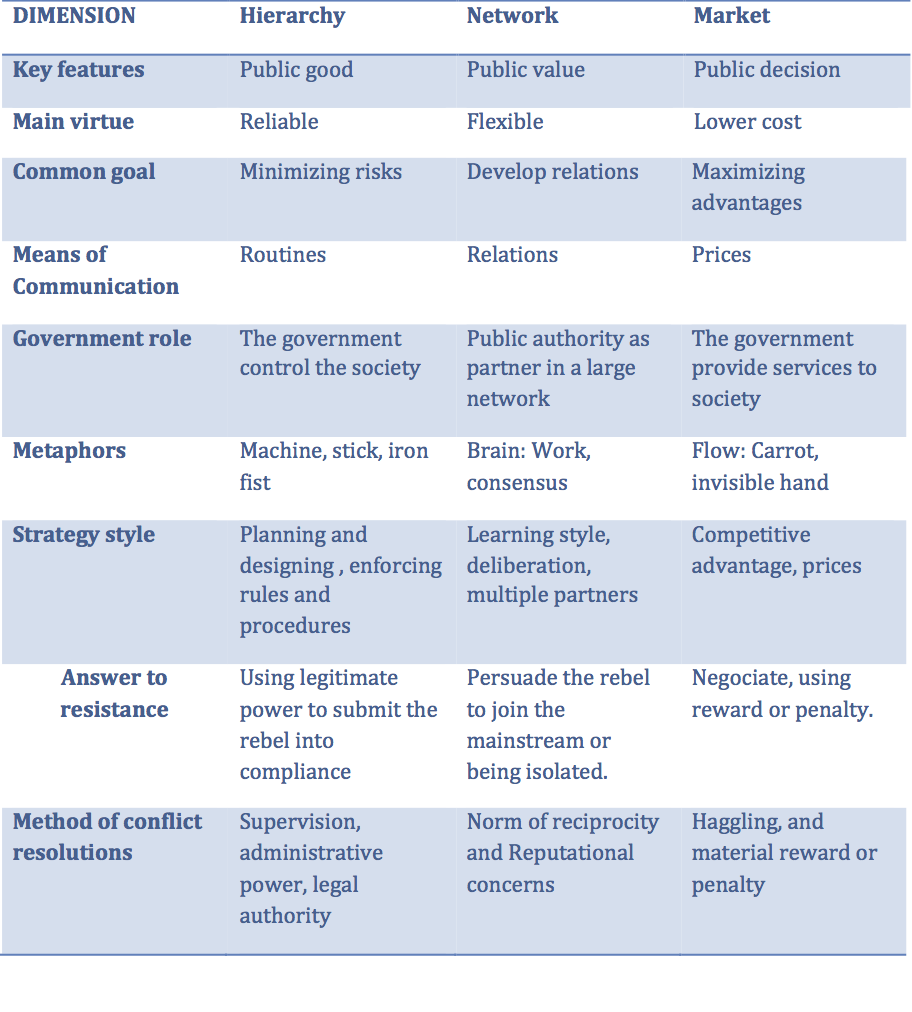Public Administration and the Meta-governance of hierarchies, Networks and Markets
Reading and comments
 “Governance” is described as follows by the IAIA – International Association for Impact Assessment: “Governance is at the heart of decision making. It is about how decisions are made, and encompasses more than the need to exhibit transparency, efficiency and public participation in decision-making. Governance determines also if and when there are opportunities for proponents, regulatory authorities and the public to interact in a balanced and respectful way. Broadly speaking, governance covers how the problems are tackled and opportunities created. This is about how, not what or why. Governance addresses issues such as the choice of institutions, instruments and processes as well as decisions about the role of those who will be affected.”
“Governance” is described as follows by the IAIA – International Association for Impact Assessment: “Governance is at the heart of decision making. It is about how decisions are made, and encompasses more than the need to exhibit transparency, efficiency and public participation in decision-making. Governance determines also if and when there are opportunities for proponents, regulatory authorities and the public to interact in a balanced and respectful way. Broadly speaking, governance covers how the problems are tackled and opportunities created. This is about how, not what or why. Governance addresses issues such as the choice of institutions, instruments and processes as well as decisions about the role of those who will be affected.”
Governance is to the public sector what management is to the private sector. And there are three approaches to governance: One based on legal authority, which is called hierarchical; one based on efficiency, which is called market-driven approach; and one bases on consensus and communication, which is here named network-oriented. Meta-governance refers to the various degrees balance between these three approaches to ensure the success of a project
Professor Louis Meulemans , Fellow Associate ( Fellow ) at VU University of Amsterdam and Senior Associate at the University of Boston, Massachusetts has published his PHD thesis on “Public Management and the Metagovernance of hierarchies , Networks and Markets: the Feasibility of designing and Managing Governance Style combinations”
In a contemporary conception of governance, some can object to hierarchical style, and others seek restoration of their values. Some seek to optimize the management of networks; others seek to maximize the benefits of the market logic applied to the public sector. All these criteria may be valid. This research aims to describe how successful leaders combine, design and manage the different leadership styles: Vertical (hierarchies), horizontal (markets) and consensual (networks). That’s what this research describes as the logic of meta- governance.
Through case studies, the author shows that governance in today’s world requires handling these three dimensions of hierarchies, markets and networks with different levels of priorities. For instance, the intervention in a situation of global crisis or the management of emergencies probably requires probably a hierarchical control style, while the remuneration of agents based on results derives from a market-based governance style; and partnerships between institutions or international contacts are governed by logic of networking.
“Governance ” means all the interactions between government and public authorities with civil society for the purpose of social or economic solutions, or creating opportunities.
For a responsible management, understanding how and when to change the governance model can make the difference between success and failure of an initiative or plan.
An important part of the research is dedicated to the identification and description of these three dimensions

Another feature of the “meta- governance” is the lack of clear separation between the social and public administration. Governments have realized that the solution to the problems of society rely not only on them but on cooperation with the private sector and NGOs. Public entities that do not adapt to this reality face serious problems, and there is no single approach to cooperation: Sometimes the civil society calls for a clear and authoritative action of the state; most of the times, the policies must be concerted through the participation of private actors in the preparation and implementation of public policy measures. Globalization increases the fluidity of the boundaries between the state and civil society and also between states. This evolution affects directly the tax administrations.
Interest of the topic for taxation
Tax administrations are generally aware of these three dimensions of modern governance but it would be interesting to identify and measure the implementation of the models in specific situations, for example, the integration of micro -enterprises in the formal economy where success may depend less than the coercion of the incentives and benefits you can provide registration simplified tax regimes. Some countries have a more “market-oriented” tradition, others rely more on hierarchical networks, and today’s TIC tend to reinforce the Network style.
The basic tax administrations vocabulary, based on concepts such as “compliance” , “enforcement ” , “control” , ” collection ” , basics of tax administration correspond more to a hierarchic view and the presence from other perspectives, market and network , are still less present in the taxation philosophy. More research would determine how states and tax compliance benefit from greater integration of network dimensions in the organization and operation of tax administrations.
A study of recent best practices in taxation could estimate how the balance between the three governance approaches could vary with activity sector, countries, time periods, and type of taxation itself.
3,234 total views, 4 views today
